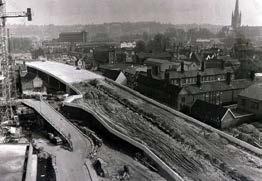
3 minute read
Stump Cross; by Chris Weston
STUMP CROSS
By Chris Weston
Advertisement
Norfolk is well-known for having unusual place names, some of which are pronounced quite differently to their spelling. The ‘top three’ usually quoted are Costessey (Cossey); Happisburgh (Hazeborough); and Wymondham (Windh-um) while around the county, numerous hamlets have names with no obvious but possibly hidden past connections. e.g. Three Hammer Common, nuear Neatishead. But even one part of Norwich has such a place, through which hundreds pass daily and thousands annually, knowing its name, but with no idea of its former existence!
You might recall paying a bus fare to or asking to be dropped off at Stump Cross, but where is that and where is the cross? Consider a journey from Tombland to Magdalen Gates. At the Maids Head Hotel, comes Wensum Street, then Fye Bridge Street, followed by Magdalen Street. But, you then temporarily leave Magdalen Street, rejoining it a short time later. The ‘missing bit’ is called Stump Cross, which has its own fascinating past. Mentioned in various sources between 1500 & 1538, it appears to have been demolished in the late 16th century. Its cross was rebuilt in 1640 before being removed in 1644. It was one place in Norwich, where the accession of a new monarch was publicly announced. Stump Cross was formerly at the fork with Botolph Street and was demolished in 1968 for construction of the Magdalen Street flyover.

Before largely vanishing however, Botolph Street was proud of two ‘treasures’, one well-known to 19th & 20th century Norwich folk, the other, not. The first, was its flagship store which opening as a haberdashery shop in 1885 and known as the pride of Stump Cross, became a Store, once with over 40 different departments. I remember the oval shaped windows on the Botolph Street side of Frank Price Ltd. Inside, were a wrought iron staircase, parquet floor in the basement with oak panelling and the pneumatic “railway” where money and receipts flew around the shop through brass-coloured tubes. Sadly by the 1960’s, it was deemed to be standing in the way of progress and was demolished in 1963, to accommodate part of the new Anglia Square. Secondly, was St Botolph’s church, a Scandinavian dedication, located slightly north of Stump Cross. It was demolished in 1548, when the parish was united with St Saviours. In 1967 human skeletal remains were uncovered during the construction of Anglia Square, presumably derived from the churchyard. St. Botolph - Patron saint of travellers and farming - was born in AD 610 at Thorney, near Peterborough, Cambs. He died in AD 680. The creation of Anglia Square meant numerous and often historic buildings were demolished in and around the Magdalen Street area. Amongst them were Woodruff’s Dolls Hospital and Nurseryfare, both demolished for the accompanying flyover considered at the time, to be some kind of super highway but which in reality, is no different to most other roads. One of the oldest demolished buildings was the Kings Arms public house on Botolph Street, which on its gable end were large iron characters and the letters "I" and "C" with the date "1646". These are now in one of the Norwich museums. And finally, today’s Anglia Square site was part of the Saxon settlement of Northwic, defended by Anglo-Scandinavian defensive ditches running along the former Botolph Street and the Anglia Square car park. Magdalen Street and St Augustine's, both date back to those times. During the 19th century, a Crape Manufactory – a factory making a fabric often worn when mourning - occupied the current Anglia Square site. The area was badly bombed during the Baedeker Raids in April 1942, during World War II and the area was deemed suitable for post-war development. The nearby Magdalen Street flyover opened on 12th June, 1972 and even this - together with Anglia Square - has become a rethink in recent years.

6 58










